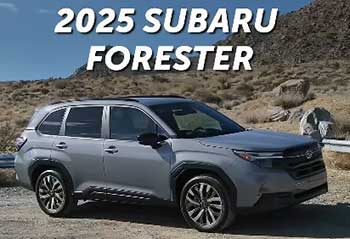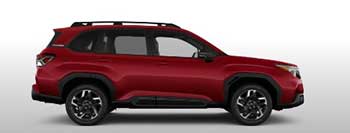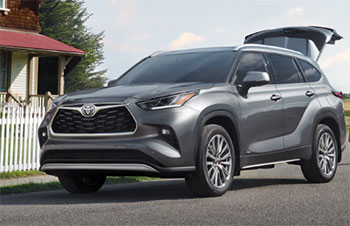
I recently found myself at a crossroads, deciding between the Subaru Forester and the Toyota Highlander for my next family SUV. Both vehicles have strong reputations, but they cater to different needs.
In this article, I’ll share my firsthand insights, comparing their features, performance, and practicality to help you choose the right one.
From pros and cons to maintenance tips and a detailed FAQ, I aim to provide a clear, engaging guide based on my experience test-driving and researching these SUVs.
Comparison Table
| Feature | Subaru Forester (2025) | Toyota Highlander (2025) |
|---|---|---|
| Starting MSRP | $31,415 | $41,815 |
| Fuel Economy (City/Highway) | 26/33 MPG (Gas), 6.9 L/100km (Hybrid) | 22/29 MPG (Gas), 35 MPG (Hybrid) |
| Engine | 2.5L 4-cylinder (180-194 hp) | 2.4L Turbo 4-cylinder (265 hp) or Hybrid |
| Drivetrain | Standard Symmetrical AWD | FWD standard, AWD optional |
| Cargo Space (Seats Up/Down) | 29.6/74.4 cu. ft. | 16.0/84.3 cu. ft. |
| Seating Capacity | 5 | 7-8 |
| Ground Clearance | 8.7 inches | 8.0 inches |
| Infotainment Screen | 11.6-inch touchscreen (standard) | 8.0-inch (base), 12.3-inch (higher trims) |
| Safety Features | EyeSight Driver Assist, DriverFocus | Toyota Safety Sense, 8 airbags |
| Warranty | 3 years/60,000 km comprehensive | 3 years/60,000 km comprehensive |
My Experience With Subaru Forester
I climbed into the 2025 Subaru Forester with high expectations, given its reputation for rugged reliability. The first thing that struck me was the visibility—those big, tall windows made me feel like I was in a glasshouse, perfect for navigating tight city streets or winding mountain roads.
The cabin felt cozy yet spacious, with 43.3 inches of front legroom and a surprisingly roomy second row. I tested the Wilderness trim, which handled a muddy trail near my home with ease, thanks to its 8.7 inches of ground clearance and standard Symmetrical All-Wheel Drive. The 2.5-liter engine, producing 180 horsepower, felt adequate but not thrilling—fine for daily commutes but a bit sluggish when merging onto highways.
The infotainment system, an 11.6-inch touchscreen, was intuitive, syncing effortlessly with my iPhone via Apple CarPlay. Subaru’s EyeSight Driver Assist system impressed me with its smooth adaptive cruise control and lane-keeping assist, though I noticed it could be overly sensitive in heavy traffic. What stood out most was the Forester’s off-road capability.
On a weekend camping trip, it tackled uneven terrain without breaking a sweat, making it a great pick for outdoor enthusiasts like me. However, the CVT transmission took some getting used to—it felt a bit floaty, lacking the crisp response I prefer.
Overall, the Forester felt like a trusty companion for someone who values adventure and fuel efficiency over luxury. Its starting price of $31,415 made it feel like a bargain, especially compared to pricier competitors. But for families needing extra seating or more power, it might fall short.
Pros Of Subaru Forester

- Affordable Starting Price: At $31,415, the Forester is nearly $10,000 cheaper than the Highlander, making it a budget-friendly option for families or solo drivers.
- Standard All-Wheel Drive: Subaru’s Symmetrical AWD comes standard, offering superior traction in rain, snow, or off-road conditions, ideal for unpredictable weather.
- Fuel Efficiency: With 26 MPG city and 33 MPG highway (or 6.9 L/100km for the hybrid), the Forester saves on fuel costs, especially for long commutes.
- Spacious Cargo with Seats Up: Offering 29.6 cubic feet of cargo space with all seats in place, it’s practical for groceries, sports gear, or camping equipment.
- Advanced Safety Features: The EyeSight system includes adaptive cruise control, lane departure warnings, and automatic emergency braking, earning a 5-star NHTSA rating.
- Off-Road Capability: With 8.7 inches of ground clearance, the Forester, especially the Wilderness trim, handles trails and rough terrain confidently.
- Excellent Visibility: Large windows and a high seating position provide outstanding visibility, making parking and navigating easier.
Cons Of Subaru Forester
- Underpowered Engine: The 2.5-liter four-cylinder (180-194 hp) feels sluggish during acceleration, especially on highways or when fully loaded.
- CVT Transmission Concerns: The continuously variable transmission can feel unresponsive and floaty, which may frustrate drivers seeking a sportier ride.
- Limited Seating Capacity: With only five seats, the Forester isn’t ideal for larger families needing a third row.
- Basic Interior Materials: The cabin uses hard plastics, which feel less premium compared to competitors like the Highlander.
- Smaller Dealer Network: Subaru’s limited dealership presence, especially in rural areas, can make servicing inconvenient, with some dealers over 60 miles away.
- Noisy Cabin at High Speeds: Engine noise and road vibration become noticeable on highways, detracting from a refined driving experience.
- Less Cargo with Seats Down: With 74.4 cubic feet of maximum cargo space, it’s outclassed by the Highlander’s 84.3 cubic feet when seats are folded.
Maintenance Tips For Subaru Forester
- Regular Oil Changes: Change the oil every 6,000 miles or six months using synthetic 0W-20 oil to keep the boxer engine running smoothly.
- Monitor CVT Fluid: Check the CVT fluid level every 30,000 miles; while sealed, leaks can occur, and replacement costs can hit $10,000.
- Tire Rotations: Rotate tires every 7,500 miles to ensure even wear, especially important for maintaining AWD performance.
- Brake Inspections: Inspect brake pads every 30,000 miles, as off-road driving or heavy loads can accelerate wear.
- Air Filter Replacement: Replace the engine and cabin air filters every 15,000 miles to maintain fuel efficiency and air quality.
- Check Head Gaskets: Around 100,000 miles, inspect for head gasket leaks, a known issue in older Subaru models, to avoid costly repairs.
- Battery Maintenance: Test the battery annually, especially in cold climates, as Subarus can be sensitive to weak batteries.
- Wiper Blade Replacement: Replace wiper blades yearly to ensure clear visibility, crucial for the Forester’s all-weather capability.
My Experience With Toyota Highlander
Stepping into the 2025 Toyota Highlander felt like entering a more polished, family-oriented space. The XLE trim I tested had a sleek, modern design with a 12.3-inch touchscreen that looked sharp but took a moment to navigate.
The 2.4-liter turbo engine, pumping out 265 horsepower, delivered a punchier response than the Forester, making highway merges a breeze. With seating for up to eight, it’s clearly built for bigger families, though the third row felt cramped for adults. Cargo space with all seats up was tight at 16 cubic feet, but folding the seats revealed an impressive 84.3 cubic feet.
The Highlander’s ride was smooth and quiet, even at highway speeds, which made long drives to my in-laws’ house more comfortable. Toyota Safety Sense, with features like blind-spot monitoring and adaptive cruise control, felt reliable, though it lacked the Forester’s unique DriverFocus system.
The optional AWD handled light snow well, but the 8-inch ground clearance meant I avoided rougher trails. At $41,815, the Highlander felt pricier, but its reputation for reliability and resale value gave me confidence. It’s a solid choice for families prioritizing space and comfort over off-road prowess.
Pros Of Toyota Highlander

- Spacious Interior: With seating for 7-8 and 84.3 cubic feet of cargo space with seats folded, it’s ideal for large families or road trips.
- Powerful Engine: The 2.4-liter turbo four-cylinder (265 hp) offers strong acceleration, outpacing the Forester for highway driving.
- Hybrid Option: The Highlander Hybrid achieves 35 MPG combined, a boon for fuel-conscious families.
- Reliable Reputation: Toyota’s track record for longevity is stellar, with some Highlanders lasting over 300,000 miles with minimal repairs.
- Premium Tech Features: Higher trims boast a 12.3-inch touchscreen and digital instrument cluster, enhancing the driving experience.
- Strong Resale Value: The Highlander retains value well, earning an Excellent rating from IntelliChoice for five-year cost of ownership.
- Comfortable Ride: A quiet cabin and smooth suspension make it ideal for long drives or daily commutes.
Cons Of Toyota Highlander
- Higher Starting Price: At $41,815, the Highlander is significantly more expensive than the Forester, impacting budget-conscious buyers.
- Optional AWD: All-wheel drive isn’t standard, adding over $1,000 to the base price, unlike the Forester’s included AWD.
- Cramped Third Row: The third row is tight for adults, limiting its practicality for larger groups.
- Lower Fuel Economy (Gas): The gas model gets 22/29 MPG, trailing the Forester’s efficiency in non-hybrid trims.
- Less Ground Clearance: With 8 inches of clearance, it’s less suited for off-road adventures compared to the Forester.
- Tight Cargo with Seats Up: Only 16 cubic feet of cargo space with all seats in place limits practicality for daily use.
- Complex Infotainment: The 12.3-inch touchscreen can feel overwhelming, with a steeper learning curve than the Forester’s system.
Maintenance Tips For Toyota Highlander
- Oil Changes: Use 0W-20 synthetic oil and change every 10,000 miles or yearly to maintain the turbo or hybrid engine’s health.
- Transmission Fluid: Check the 8-speed automatic transmission fluid every 60,000 miles to prevent wear and ensure smooth shifting.
- Tire Maintenance: Rotate tires every 7,500 miles and check alignment, as the Highlander’s weight can cause uneven wear.
- Brake Pad Replacement: Inspect brakes every 30,000 miles; replace pads sooner if towing or driving in heavy traffic.
- Coolant Flush: Flush the cooling system every 100,000 miles to protect the engine, especially in hybrid models.
- Battery Checks: For hybrids, have the battery pack tested every 50,000 miles; for gas models, check the 12-volt battery annually.
- Air Filters: Replace engine and cabin air filters every 15,000 miles to optimize fuel economy and cabin comfort.
- Belt and Hose Inspections: Check belts and hoses every 30,000 miles, as some owners report replacements around 100,000 miles.
Comparison With Other Brands
- Honda CR-V vs. Subaru Forester: The CR-V offers better fuel economy (28/34 MPG) and a smoother ride but lacks standard AWD and the Forester’s off-road prowess. Its interior feels more upscale, but cargo space (75.8 cu. ft. max) is similar.
- Mazda CX-5 vs. Subaru Forester: The CX-5’s turbo option (250 hp) outpowers the Forester, and its interior is more luxurious. However, its 6.5-inch ground clearance limits off-road ability, and AWD isn’t standard.
- Kia Telluride vs. Toyota Highlander: The Telluride offers a more spacious third row and a 291-hp V6, but its fuel economy (20/26 MPG) lags behind the Highlander Hybrid. It’s also pricier, starting at $43,000.
- Hyundai Santa Fe vs. Toyota Highlander: The Santa Fe’s bold design and 277-hp turbo engine compete well, but its 19/26 MPG trails the Highlander Hybrid. It offers similar cargo space but a less proven reliability record.
- Subaru Ascent vs. Toyota Highlander: The Ascent, Subaru’s three-row SUV, matches the Highlander’s seating but offers standard AWD and more cargo space (17.8 cu. ft. behind third row). Its 260-hp turbo engine is slightly less powerful.
- Ford Explorer vs. Toyota Highlander: The Explorer’s 300-hp V6 and 87.8 cu. ft. max cargo outshine the Highlander, but its 20/28 MPG and higher repair costs make it less economical.
- Nissan Rogue vs. Subaru Forester: The Rogue’s 201-hp turbo engine and 28/35 MPG edge out the Forester in efficiency, but its 7.1-inch ground clearance and optional AWD limit off-road capability.
Also read: My Thoughts on Ford Edge Vs. Hyundai Tucson
Frequently Asked Questions (FAQ)
It depends on your needs. The Forester is better for budget-conscious buyers, off-road enthusiasts, and those prioritizing fuel efficiency. The Highlander suits larger families needing more seating and cargo space, with a stronger engine and hybrid option.
The Forester’s weaknesses include an underpowered engine, a floaty CVT transmission, limited five-seat capacity, basic interior materials, and a smaller dealer network, which can complicate servicing.
The Subaru Ascent is the closest equivalent, offering three-row seating, standard AWD, and comparable cargo space, though it’s slightly less powerful than the Highlander.
The Highlander is better for families needing three rows and a powerful engine. The Outback excels for smaller families or adventurers, with standard AWD, better fuel economy (26/33 MPG), and a wagon-like design.
Conclusion: For Subaru Forester
If you’re like me, craving adventure without breaking the bank, the Subaru Forester might be your match. Its standard AWD, fuel efficiency, and off-road capability make it a fantastic choice for tackling trails or snowy commutes. You’ll love the visibility and cargo space for daily errands or camping trips, but be prepared for a less powerful engine and a basic interior. For smaller families or solo drivers, it’s a reliable, budget-friendly option that punches above its weight.
Conclusion: For Toyota Highlander
For those of you with larger families or a preference for comfort, the Toyota Highlander shines. Its spacious interior, powerful engine, and hybrid option cater to long road trips and heavy loads. You’ll appreciate the smooth ride and strong resale value, though the higher price and optional AWD might give you pause. If seating and reliability are your priorities, the Highlander is a solid investment.

